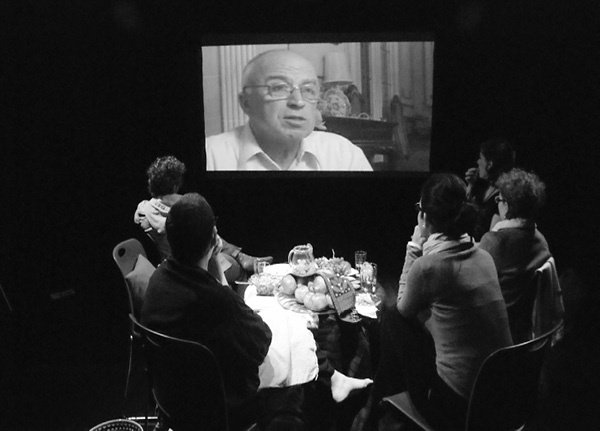
HOME BEAUTIFUL - INVITING THE ANCESTORS
first performed on
October 22, 2011
Matralab, Concordia University, Montreal, Canada
performed once in 2011
DEVORA NEUMARK
Rana Alrabi, Rula Odeh, Sonia Zylberberg and Diana Yaros
Montreal, Quebec, Canada
776589831f776589831i776589831r776589831e776589831s776589831i776589831d776589831e776589831@776589831p776589831r776589831o776589831g776589831r776589831e776589831s776589831s776589831i776589831o776589831n776589831.776589831n776589831e776589831t
devoraneumark.com
HOME BEAUTIFUL - INVITING THE ANCESTORS
DEVORA NEUMARK
Gathering for the first time during this live art event, five women-Jewish, Muslim and Christian-shared their stories of the Holocaust and the Nakbah while reflecting on beauty and (the loss of) home. The Jewish holiday of Sukkot provided us with a perfect opportunity to gives thanks for the harvest and acknowledge the experience of our elders, while keeping our hearts open to the plight of people around the world whose temporary dwelling (in refugee camps, for example) is not voluntary.
“Home Beautiful: Inviting the Ancestors” (like the other live art event in the “Jewish Home Beautiful-Revisited” series), was based on the Jewish Home Beautiful community pageant, written by Betty D. Greenberg and Althea O. Silverman in the 1930s and consisting of multiple holiday table settings and foods, traditional songs, and readings. Unlike the original, this critical non-scripted re-enactment troubled the construction of personal and cultural narratives and questioned the ways in which such storytelling efforts shape our experience of home(land). Central to the connections between the aesthetic and political intentions behind the original Jewish Home Beautiful was the historical moment when it first appeared-the forced displacements of Jews in the shoah (Hebrew for “the holocaust”) and the simultaneous maneuverings leading up to the al Nakbah (Arabic for “the catastrophe”-referring to the May 1948 transfer of British colonial rule in Palestine to the State of Israel, which resulted in the occupation of Palestinian land and was marked by forced expulsion, ethnic cleansing, and massacres in Palestinian villages). While the Jewish Diasporic experience has been mitigated, in part, due to the performativity of cultural constructions such as the Jewish Home Beautiful, the domicide-that is the politically motivated willful destruction of houses and homes that has been and continues to function as a major weapon in the arsenal of cultural oppression-impacting Palestinians continues to escalate.
For three hours on Saturday, October 22, 2011, the five of us reflected on our individual and collective experiences of loss as Jews and Palestinians and wondered out-loud about how beauty strengthens resilience. We spoke about the objects we each brought to the table for this occasion, each of which paid homage to a particular ancestor whose own experience with home and beauty we wanted to honour-family photographs, embroidered handwork, ceramics-and we sang and shared food. We were amicable towards each other as we mourned and celebrated together. We left questioning how to continue the conversation amongst us and how to get to a place where we could reveal and care for the hidden and unspoken injustices that have been and continue to be the experience of the vast majority of Palestinians.